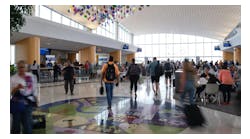An airport is the safest place to fly a drone. Surely that statement would strike anyone in aviation as counterintuitive, to put it mildly. After all, sightings of unauthorized Unmanned Aerial Systems (UAS) flying near airports already amount to an unsettling problem: Reports of possible drone sightings to FAA air traffic facilities rose to 1,274 incidents in 2016, up from 874 the year before, according to the FAA. It is a global problem as well. Take what happened this past November at Congonhas in São Paulo. After a pilot reported seeing an unidentified drone circling above one of the runways, authorities shut down operations for more than two hours. Hundreds of passengers were stranded as airlines cancelled flights into and out of the city. These precautions were perfectly rational: The mere thought of UAS straying over runways tends to evoke images of catastrophe—drones being sucked into jet engines, snarled in helicopter rotors or plastered onto aircraft windshields, to name just a few of the grim possibilities.
Prudence about such dangers is precisely why federal officials, as part of the congressionally mandated integration of UAS into the National Airspace System (NAS), moved to ban drone flights within five miles of any airport. Ironically, however, a strong argument can be made that the object of these concerns—UAS—can actually be a powerful tool to improve the safety, efficiency and cost-effectiveness of U.S. airport operations in the years ahead.
To be clear, the dangers posed by the unauthorized use of drones—whether in the hands of terrorists or hobbyists—over American airports are unmistakable and require vigilance. However, another scenario has received scant attention despite its potential upside: namely, the tightly controlled and narrowly defined operation of UAS to execute critical tasks such as Foreign Object Debris (FOD) inspections; “eye-in-the-sky” security flyovers; fuselage inspections; wildlife detection/deterrence, and more.
If you think about it, potentially the safest airspace in the world is over U.S. airports. After all, no part of the NAS is as tightly controlled and monitored. Consider for a moment the broad reach of the FAA. Its mandate includes the vast majority of U.S. airspace—from the ground up, coast-to-coast—with generalized preemption of state and local controls by decree of the U.S. Supreme Court. Under Part 107 of the Federal Aviation Regulations, moreover, the FAA already regulates UAS and has set initial maximums for altitude (400 feet), weight (55 pounds), airspeed (100 mph) and other aspects of legally authorized UAS operation.
The FAA’s reach likewise extends to the airport environment itself, where most air traffic controllers are FAA employees and even those working for the Contract Tower Program must follow FAA procedures, subject to monitoring and surveillance. With the exception of uncontrolled airports that lack towers, no aircraft uses a runway and nothing stirs on airport movement surfaces without FAA sanction.
If the FAA shuts down all operations, in other words, the airport is essentially on lockdown—conditions in which it is perfectly safe for trained, monitored and authorized operators to fly UAS in service of defined tasks. Pausing activity in this way would hardly be unprecedented: Airports and the FAA routinely work together to put a temporary halt to operations, either as part of existing inspection schedules or for emergency response.
The drone revolution takes off
The revolution in UAS continues to bring new capabilities and efficiencies to a wide array of entities in both the private and public sectors. The National Transportation Safety Board (NTSB) is a case in point. Prior to embracing UAS, NTSB investigators would walk accident debris fields to map them by hand in a meticulous and time-consuming process. Today, they fly drones over these areas to map them in a fraction of that time. Employing UAS in this way also gives NTSB an overhead, permanent record of the accident site. For NTSB, drones have been a game-changer. In the private sector, meanwhile, companies are using drones to inspect pipelines, power lines and railroad tracks; to dust crops; to enhance the security of parking lots or other expansive areas; to get aerial shots for movies and TV shows; and to inspect or photograph properties for insurance or real estate purposes, to name just a few uses of UAS.
While drones are cheaper, more readily available and easier to pilot than ever before, they are not in and of themselves new (the U.S. military has used UAS for 30 years). Often, the real advances can be found in the types of sensors and cameras hanging from the drones. Indeed, these technologies are often light years more advanced than the plastic and carbon fiber vehicles themselves. By combining UAS with remote-sensing Light Detection and Ranging (LiDAR) technology, for instance, archeologists have been able to discover new sites in areas already explored by trowel, everywhere from Stonehenge to the Giza Plateau.
Potential UAS benefits for airports
As these types of technologies continue their rapid evolution, they will offer ever-greater potential benefit to U.S. airports. Instead of sending multiple human beings and vehicles onto the runways to look for FOD, for example, a drone with advanced debris-detection sensors could, in theory, execute the same task with greater accuracy and in less time. Along the same lines, specialized UAS could improve the efficiency of snow-and-ice inspections at large airports in the Northeast. Armed with ultra high-resolution cameras, drones could aid in the detailed external inspection of aircraft fuselages, possibly eliminating the need to put inspectors on scaffolds or in basket trucks. Potentially, UAS could even be employed to monitor or deter birds/wildlife at or near airports. As far as security is concerned, drones clearly add enormous capabilities. A drone with “night vision” technology could spot a trespasser lurking around the airport—and record the evidence for later use.
None of this is to suggest that drones are a must-have for all airports. With respect to FOD, for example, many airports already employ electronic, fixed-in-place systems that rely upon various types of sensors or radars to detect debris. These systems also operate 24/7. They are, however, quite costly. For some airports, using a drone to examine the runways several times a day could be a good option.
The regulatory dimension
While drones are currently prohibited from operating at airports, in all likelihood FAA could approve their use without a regulatory change. One could imagine a port authority or airport requesting an FAA waiver to allow the use of UAS for FOD inspections, for instance. So long as both the airport’s director of operations and the manager of the ATC tower were in agreement about the proposed use of the drone, it is conceivable FAA would consent to the waiver. Naturally, the new use would trigger a discussion among FAA officials in Washington of the appropriate procedures and processes required to ensure safety. My vote would be for the aviation industry to start thinking about these possibilities now.
The average person sees drones as a threat to air safety. Moving forward, federal officials and airport operators would do well to question this conventional wisdom. Specialized UAS could be a boon to airport efficiency and safety—possibly even allowing for better monitoring of unauthorized drone flights by irresponsible hobbyists. UAS is one of the fastest-growing segments in aviation. Why ground the technology at American airports when, under controlled conditions, it could yield valuable new perspectives?
Veteran aviation attorney Mark A. Dombroff is an Alexandria, Va.-based shareholder in LeClairRyan and co-leader of the national law firm’s aviation industry practice; [email protected].





